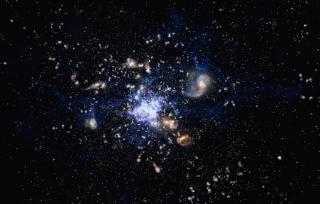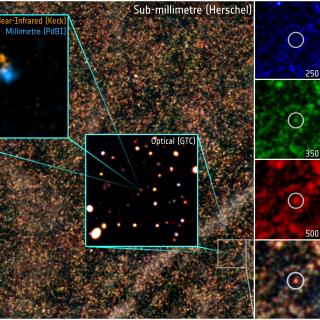Bibcode
Fudamoto, Y.; Oesch, P. A.; Walter, F.; Decarli, R.; Carilli, C. L.; Ferrara, A.; Barrufet, L.; Bouwens, R.; Dessauges-Zavadsky, M.; Nelson, E. J.; Dannerbauer, H.; Illingworth, G.; Inoue, A. K.; Marques-Chaves, R.; Pérez-Fournon, I.; Riechers, D. A.; Schaerer, D.; Smit, R.; Sugahara, Y.; van der Werf, P.
Referencia bibliográfica
Monthly Notices of the Royal Astronomical Society
Fecha de publicación:
5
2024
Número de citas
17
Número de citas referidas
14
Descripción
We present results of dust continuum and [C II]$\, 158\, {\rm \mu m}$ emission line observations of a remarkably UV luminous (MUV = -21.6) galaxy at z = 10.603: GN-z11. Using the Northern Extended Millimeter Array (NOEMA), observations have been carried out over multiple observing cycles. We achieved a high sensitivity resulting in a $\lambda _{\rm rest}=160\, {\rm \mu m}$ continuum $1\, \sigma$ sensitivity of $13.0\, \rm {\mu Jy \, beam}^{ -1}$ and a [C II] emission line $1\, \sigma$ sensitivity of $31\, \rm {mJy\, beam^{ -1}\, km \, s}^{ -1}$ using $50\, \rm {km \, s}^{ -1}$ binning with a $\sim 2\, {\rm arcsec}$ synthesized beam. Neither dust continuum nor [C II]$\, 158\, {\rm \mu m}$ line emission are detected at the expected frequency of ν[C II]$= 163.791\, \rm {GHz}$ and the sky location of GN-z11. The upper limits show that GN-z11 is neither luminous in LIR nor L[C II], with a dust mass $3\, \sigma$ limit of ${\rm log}\, (M_{\rm dust}/{\rm {\rm M}_{\odot }}) \, \lt\, 6.5-6.9$ and with a [C II] based molecular gas mass $3\, \sigma$ limit of log (Mmol, [C II]$/{\rm {\rm M}_{\odot }}) \, \lt \, 9.3$. Together with radiative transfer calculations, we also investigated the possible cause of the dust poor nature of the GN-z11 showed by the blue colour in the UV continuum of GN-z11 (βUV = -2.4), and found that ≳3 × deeper observations are crucial to study dust production at very high-redshift. Nevertheless, our observations show the crucial role of deep mm/submm observations of very high-redshift galaxies to constrain multiple phases in the interstellar medium.
Proyectos relacionados

Gas Molecular y Polvo en Galacias através del Tiempo Cósmico
Dos cuestiones fundamentales en la Astrofísica son la conversión de gas molecuar en estrellas y cómo este proceso físico depende del entorno en todas las escalas, desde sistemas planetarios, cúmulos estelares, galaxias hasta cúmulos de galaxias. El objectivo principal de este proyecto es el de estudiar la formación y evolución de galaxias a partir
Helmut
Dannerbauer

Formación y Evolución de Galaxias: Observaciones Infrarrojas y en otras Longitudes de Onda
Este grupo desarrolla varios proyectos extragalácticos en diferentes rangos del espectro electromagnético utilizando satélites y telescopios en tierra para estudiar la evolución cosmológica de las galaxias y el origen de la actividad nuclear en galaxias activas. En el aspecto instrumental, el grupo forma parte del consorcio internacional que ha
Ismael
Pérez Fournon